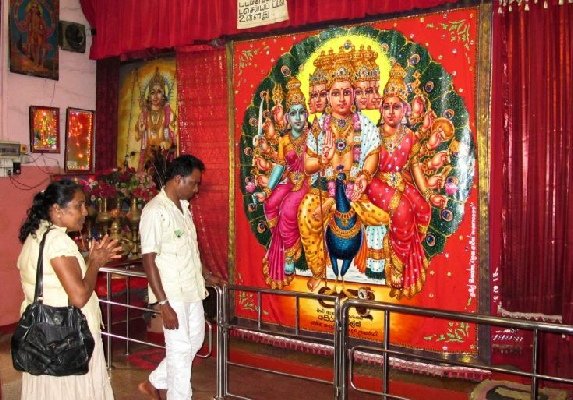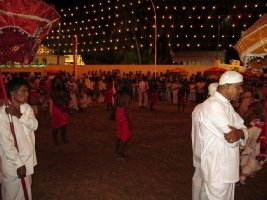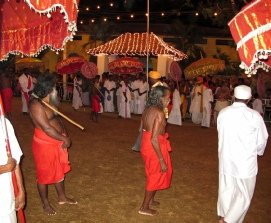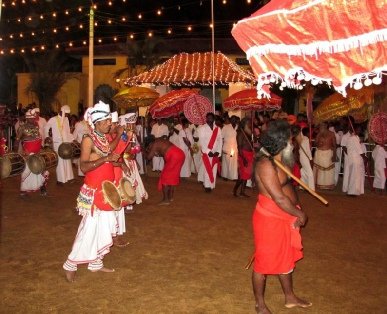© 2023 Dr Margaret Sheppard
Kataragama
The Deity Kataragama’s main Temple is in the South of Sri Lanka at Kataragama Town. This is a well known pilgrimage site and draws pilgrims not only from throughout Sri Lanka but also from further afield. Every July thousands attend the spectacular Peraheras in honour of Kataragama. Some still undertake the 45 day traditional pilgrimage route on foot, from the far North of the Island, down the East coast and then via Yala to this holy Temple site. The route is over 300 miles long. It should be noted that the site is sacred not only to Buddhists and Hindus but also there is a Mosque where a Moslem Saint is buried.
There are many myths concerning Kataragama and his origins, several of which are sung and danced in the Pattini ceremonies. For example he is considered to be a reincarnation of the Deity Vishnu/Isvara and son of Shiva, to have two wives Valliamma (of Veddah descent) and an Indian princess called Tevayani. His Veddah wife Valliamma, is attributed with supernatural parentage. Although brought up by the Vedda people -
Hindus refer to him as Skanda or Muragan who is the Deity of war, but in Sri Lanka he is also referred to as the Prince of the Mountains -
In these ancient times the legend relates that Sri Lanka was still connected to Madagascar. A terrible giant ruled this land between Sri Lanka and Madagasgar of whom even the Deities were afraid. They begged Shiva to help them and he sent his son Skanda (Kataragama) down to earth to fight this giant but the giant fled to the bottom of the sea to avoid Skanda’s lance. The land where the giant had ruled became flooded by sea and the giant was seen no more.
Skanda decided to move to Katargama where he married the beautiful Valli-
Another legend relates that Kataragama came to Sri Lanka from the Malabar coast landing at Sinigama (near Hilkkaduwa) the people built a Shrine in his honour. However he moved from here when the people became fishermen and started to dry fish in the sun. He could not stand the smell so moved further South, but the villagers here also became fishermen and the same problem arose so he moved again twice more but each time when the villagers started to dry fish he left ending up in Deondra in the South where yet another Shrine was raised in his honour. When the residents of Deondra also started fishing and drying fish he moved inland to Kataragama where he settled up in the fresh air of the 2,500 feet high Vedahitiya-
Not only is the Kataragama area sacred to the Buddhists, Moslems and Hindus but it is also venerated by the Veddah people and there is a small temple called Valli-





Shrine to Kataragama where supplicants can approach the Deity via the Shrine Guardian (in white). They place their money offerings in the box, then make their request to the Guardian who is holding the peacock tail feathers (emblem of Kataragama).
The Guardian then addresses the images of Kataragama using the correct form of address, and presents the request. Pilgrims also may tie a coin in a strip of cloth with their request, and place this wish on the stand in front of the Shrine.
Supplicants tend to use this Shrine at the entrance to the main Temple outside the formal Pujah hours.







Veddah men in the Kataragama Esala (July) Perahera Procession. They parade immediately in front of the main Temple elephant that bears the holy relic -
From time to time during the procession, the Veddah men perform obeisance to the sacred relic by turning to face the elephant and bowing low towards the relic.
Kataragama is a Deity whom many fear and is believed to demand penitential vows from humans in exchange for his assistance. Pilgrims and supplicants thus can be seen carrying out their vows by e.g. walking on fire, walking on nails or being suspended by hooks pierced through their skin.
The first Temple for Kataragama was allegedly built in gratitude during the first century B.C., by Dutugemunu, the king of the Singhalese. (See section on Temple for more details).